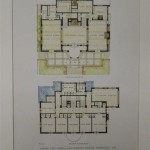Simple Cost-Efficient House Plans: Building Your Dream Home Without Breaking the Bank
Building a house is a significant investment, and it's essential to carefully consider all aspects of the project, including the design and construction costs. While elaborate and luxurious homes may be tempting, choosing a simple and cost-efficient house plan can save you a considerable amount of money while still achieving your dream living space. Several factors influence the cost of a house, and understanding these factors can help you make informed decisions when selecting a plan.
1. Square Footage and Complexity
One of the most significant factors affecting construction costs is the total square footage of the house. Larger houses require more materials, labor, and time to build, leading to higher expenses. Similarly, complex designs with multiple levels, elaborate rooflines, and intricate details can also add to the cost. Opting for a smaller, simpler house plan with a straightforward layout can significantly reduce overall construction expenses.
Consider carefully the necessary living space for your family's needs. A modest two-story design can often provide ample room for a family without the added cost of expanded square footage. Prioritize essential spaces and eliminate unnecessary rooms to lower construction costs. Focus on efficient layouts that maximize space utilization with a streamlined design.
2. Material Choices and Features
The materials used in construction play a crucial role in determining overall costs. Choosing cost-effective but durable materials can significantly impact the budget. Basic building materials like concrete blocks, wood framing, and asphalt shingles are generally cheaper than premium options like brick, steel, or tile. Consider exploring alternatives to expensive materials, such as using engineered lumber for framing or vinyl siding instead of wood.
Minimize the use of complex and expensive architectural features that add little to the functionality of the house. For example, consider simple windows and doors instead of custom-designed ones. Opting for standard sizes and materials can save you money both in purchasing and installation. Consider using readily available fixtures and finishes to avoid the premium costs of custom-made or imported items.
3. Building Codes and Regulations
Local building codes and regulations can influence the design and construction costs of a house. Stricter codes may require additional structural reinforcement, insulation, or fire safety measures, which can increase expenses. Researching the specific requirements for your location can help you choose a plan that complies with the codes while minimizing unnecessary costs.
Consider choosing a plan that is designed to meet the minimum code requirements. Collaborate with an architect or builder who is familiar with the local regulations to ensure compliance and avoid potential delays or costly revisions during the construction process. Exploring alternative building strategies, such as prefabricated walls or modular construction, can sometimes be a more cost-effective option in certain jurisdictions.
4. Labor Costs and Availability
Labor costs vary significantly depending on the region and the availability of skilled workers. Choosing a simple and straightforward plan can reduce the amount of labor required for construction, resulting in lower overall costs. Consider exploring construction methods that require less labor, such as using prefabricated components or employing skilled workers who can perform multiple tasks.
Negotiate with contractors to get competitive bids on your project. Consider using local contractors or subcontractors who may offer more affordable rates than large construction companies. Building during the off-season when demand for labor is typically lower can also help reduce construction costs.
5. Site Considerations
The site where the house will be built can also affect construction costs. Uneven terrain, difficult access, or the need for extensive site preparation can all add to the expenses. Choosing a level site with easy access for construction equipment and materials can minimize site preparation costs. If possible, consider building on a lot that has existing utilities and infrastructure, which can reduce the cost of connecting your house to the services.
Prioritizing a simple and cost-efficient house plan can significantly reduce the overall cost of building a home without compromising quality or functionality. By carefully considering the factors discussed above, you can make informed decisions about every aspect of your project and achieve your dream home within a manageable budget. Remember, building a home is a journey, and every step you take can impact the final cost. Through thoughtful planning, careful design, and smart choices, you can create a beautiful and affordable living space that meets your needs and fulfills your vision for your home.

Building On The Affordable House Plans Of 2024 Houseplans Blog Com
Est House Plans To Build Simple With Style Blog Eplans Com

Est House Plans To Build Simple With Style Blog Eplans Com

Est House Plans To Build Simple With Style Blog Eplans Com

Affordable House Plans Our Est To Build Blog Homeplans Com

Est House Plans To Build Simple With Style Blog Eplans Com

Stylish And Simple Inexpensive House Plans To Build Houseplans Blog Com

Low Budget Simple House Design Plans For Builders Blog Builderhouseplans Com

Stylish And Simple Inexpensive House Plans To Build Houseplans Blog Com

Stylish And Simple Inexpensive House Plans To Build Houseplans Blog Com








